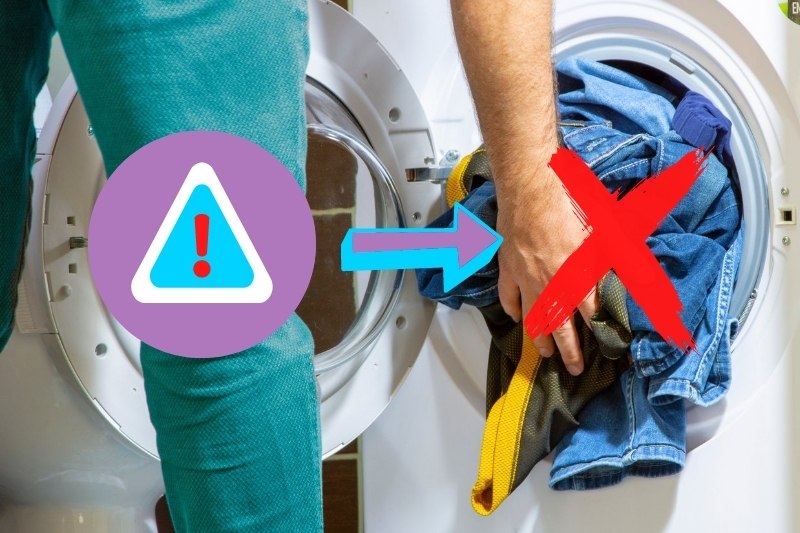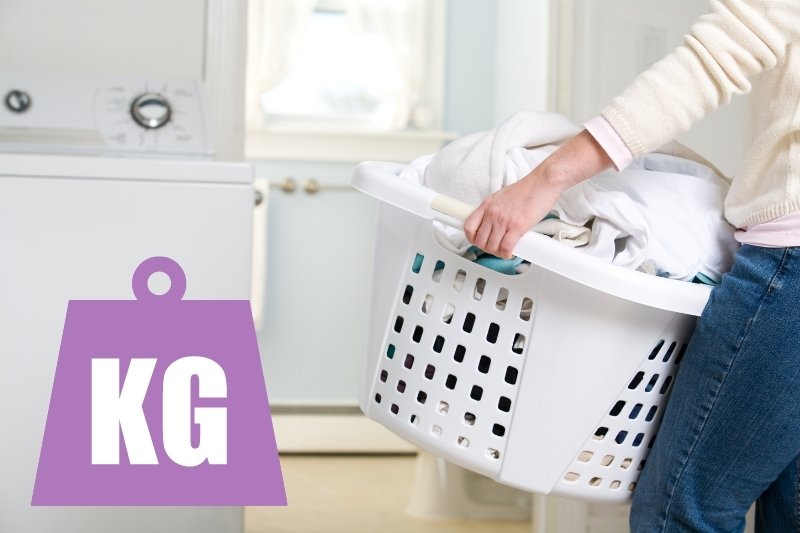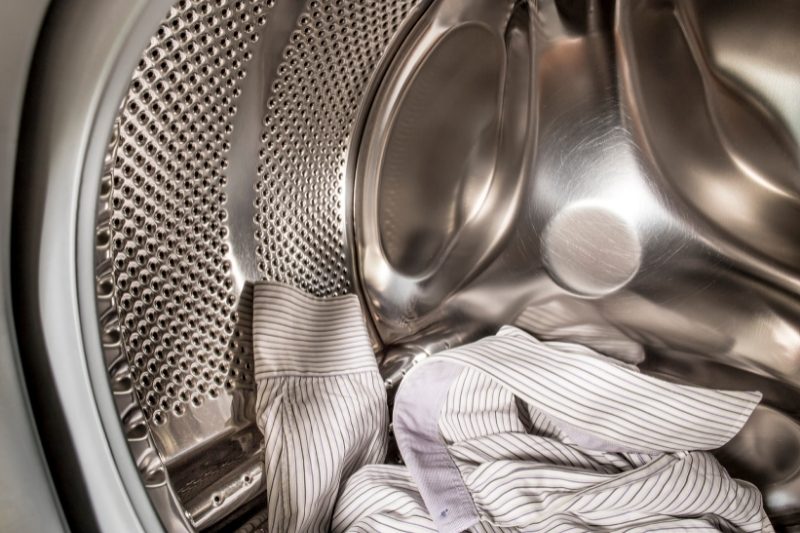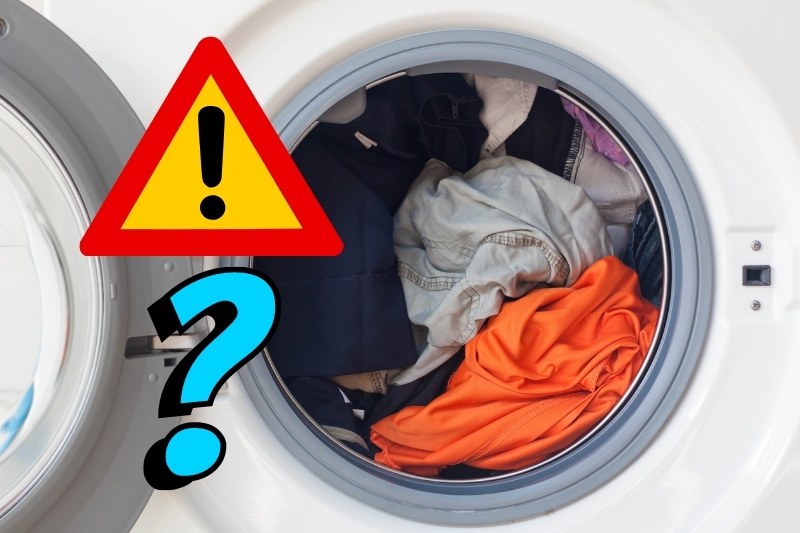Economising on your laundry loads is essential. It saves water and electricity, which is great for your wallet and the planet, and saves you time.
Whilst it might seem like the best way to do this is by filling the washing machine with as many clothes as possible, there is such a thing as overloading a washing machine.
Many people are unaware that this can be damaging, not only their clothing, but also their machines.
Read on to find out what happens if you overload a washing machine and how much is too much.
What Happens to Your Clothes if You Overload the Washing Machine?

If your clothes are too tightly packed into your washing machine, they won’t have enough space to move around and separate from one another. This means that water and detergent can’t be evenly distributed and might not reach all of your items, or at least all parts of your items.
On one hand, the excess detergent builds up in one area and can leave a residue on your clothes. On the other hand, clothes, or parts of clothing, that don’t get any detergent remain dirty and stained.
You will have to then put these clothes back in the washing machine which is a waste of water, detergent and your time!
In addition to this, when a washing machine is overloaded, the clothes end up pressing against the door. As they spin round, they can get caught on the rubber door seal and rip.
What Happens to the Washing Machine if You Overload It?

Whilst having to wash your clothes again doesn’t seem too serious, an overloaded washing machine can also cause damage to your machine such as:
- Blocked pipes: Smaller items of clothing can end up getting pushed into the drainage pipe and get stuck. This can cause the machine to stop mid-cycle, leaving you with sodden clothes.
- A leaking machine: If the water can’t properly drain from the machine, it may end up escaping from other parts of the machine and onto your floor.
- Damage to the drum: The combination of the sealed door and the high spinning speed can create a lot of pressure in the drum. If the drum is too full, this can put pressure on the bearings, the alignment, the motor and even cause the glass to crack.
These issues require professional help to fix which could be very costly. Especially if the machine is damaged beyond repair.
How Much Should You Fill Your Washing Machine?

The maximum load weight for each washing machine is usually detailed in the instruction manual, but can also be indicated on the front of the machine itself. This weight refers to dry clothing.
If you are able, you could weigh the clothes you need to wash before loading them into the machine. That way, you can add or remove items as appropriate.
However, if you are unable to weigh your clothes, aim to fill the drum three quarters of the way to the top. If that seems abstract, you can test it by putting your hand on the top of the load.
There should be enough space between the top of the pile and the top of the drum to easily place your hand. If you can’t get your hand in, or you have to force it, the machine is overloaded.
Even if you don’t cause any immediate damage to your machine or your clothing, if the drum is too full there won’t be sufficient water.
This means the detergent won’t properly dissolve and your clothing may still be dotted with washing powder or covered with liquid gel even after the cycle has finished.
Loading Your Machine Correctly

It might seem a bit of a faff, but it’s actually worthwhile working out loads based on the capacity of your washer. This will maintain wash efficiency, ensure good circulation of detergent, and produce sparkling clean results!
A pro tip is to weigh your load prewash. Just work out the weight of a perfect load (outlined below) and use a lightweight mesh bag to hold the load in place on the scales.
Another tip is to evenly spread larger items, such as bed sheets, around the drum, so that the weight is distributed evenly.
Generally, it’s best to refer to the appliance manual to find the maximum capacity of the washing machine.
However, if you can’t for the life of you remember where you’ve put your owner’s manual – make sure that there is about a 10 cm gap between the top of your load (once it’s in the machine) and the top of the drum. Most machines are designed to handle roughly 7 kg of laundry.
Here is a rough guide of what various drum sizes can manage:
- 6 kg: 5 hand towels, 6 t-shirts, 2 pairs of jeans, 1 jumper, 10 pairs of socks or underwear, 2 bed sheets
- 7 kg: 5 hand towels, 10 t-shirts, 4 pairs of jeans, 1 jumper, 20 pairs of socks or underwear, 2 bed sheets
- 10 kg: 8 hand towels, 15 t-shirts, 4 pairs of jeans, 2 jumpers, 30 pairs of socks or underwear, 3 bed sheets
It’s also handy to bear in mind that there is a difference between weight and volume! It might sound stupid, but 3 kg of t-shirts won’t take up the same amount of space as 3 kg of jeans.
How Much Clothing Can Be Put in an 8 kg Washing Machine?

The manufacturer’s guide will provide specific information about your model of washing machine. If you want to be precise, you can bag up your laundry into a mesh bag and weigh it before placing in the drum.
However, most people just judge the right amount of laundry by looking and feeling with their hands.
Washing machines are described by their size; this relates to the weight of the laundry that can be contained within the drum. For example, an 8kg machine can cope with 8kg of laundry.
Obviously, the size of the items being washed will also be pertinent. It’s possible to get a very large item that weighs very little (such as a lightweight duvet) that changes how much your drum can carry.
However, using a more general guide such as t-shirts, it’s possible to say very approximately how much each size of washing machine can accommodate.
An 8 kg machine is a good option for a medium-sized family and will fit around 40 t-shirts at once. In contrast, a 5 kg washing machine will only fit about 25 t-shirts, while a 12 kg machine will fit about 60 t-shirts.
Is Underloading a Washing Machine Bad?

If worrying about overloading wasn’t enough, you can also underload your machine too!
Fortunately, it’s unlikely to damage the machine if you underload it. Instead, you will most likely have to put up with loud banging and heavy vibrations. But it’s also a waste of money, water and time, so it’s best to wait until you have enough clothes to run a cycle.
If you don’t put enough items in your washing machine, they may bunch up on one side rather than spreading out across the drum in the way that a larger load is forced to do.
A load that doesn’t spin will come out of the machine dripping wet, with lots of excess water that takes a very long time to dry.
The washing may also bang very loudly if you do manage to get it spinning, making the cycle deeply unpleasant for everyone in the household.
Quite aside from the mechanics of under loading your machine, it’s not economical or environmentally friendly.
Running half-empty loads will use more water than necessary and means you’ll be using energy to run the machine more frequently.
Keep your washing until you have a full load and you’ll save the planet and your bank balance in the process.

In The Wash is your guide to the best laundry and cleaning products, tips and tricks. Our mission is to solve the UK’s cleaning and laundry dilemmas!






